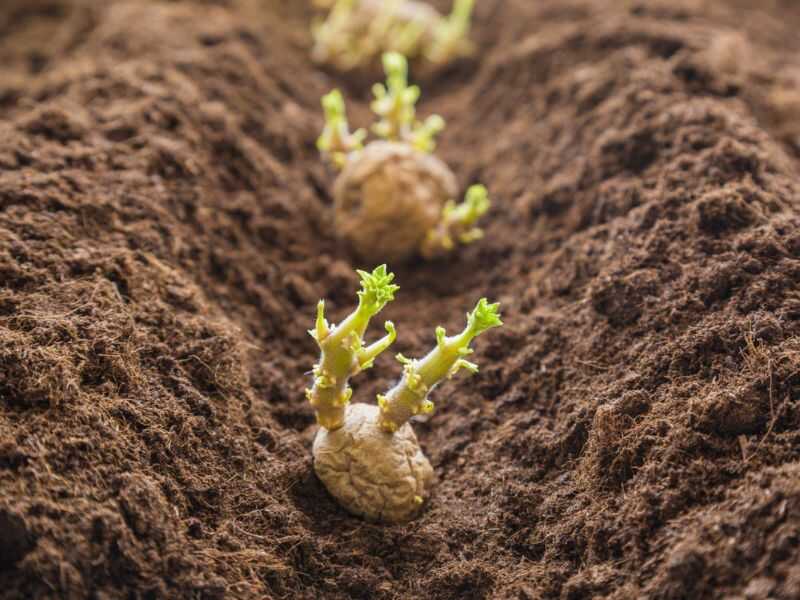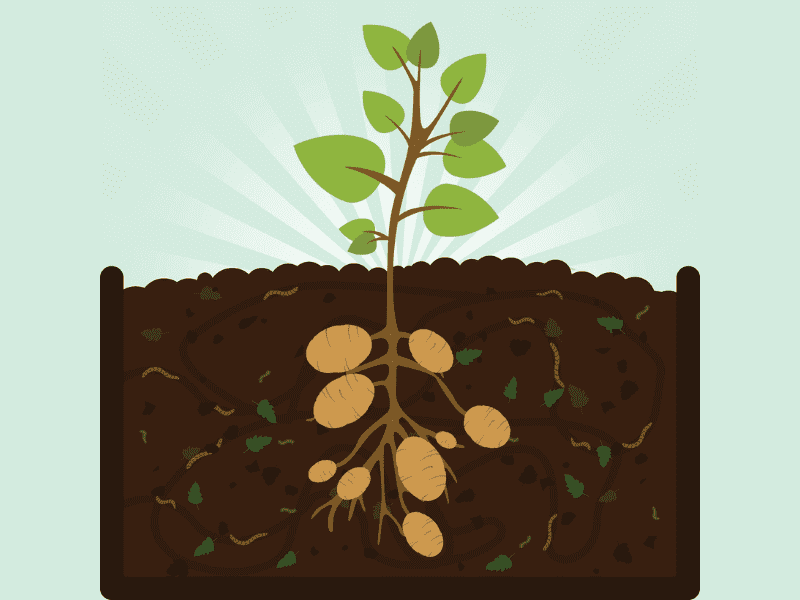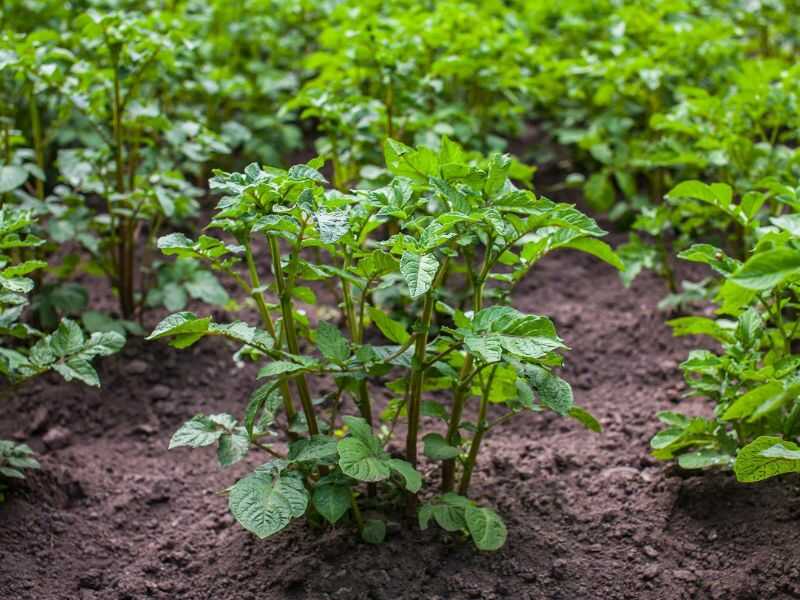
Looking to put your garden to good use this year? Knowing how to grow potatoes is a great way to supplement your groceries purchase and start saving money on food. Planting them in your backyard garden or even in containers makes it even easier!
Growing potatoes doesn't have to be difficult, and it doesn't have to be expensive. In fact, if you know a few tricks of the trade, you'll find that potatoes are just as easy to grow in your backyard as they are at the grocery store!
How to Grow Perfect Potatoes in Your Garden

Planting potatoes is easier than you think! Potatoes can be grown on any soil and don't need much care in the way of fertilizers or irrigation. They're a great way to supplement your diet with healthy, organic food. If you have some extra space in your garden, why not grow a few sacks of potatoes?
You’ll need some good quality seed potatoes (you can buy them online or at your local nursery). A shovel (or trowel) for digging up soil and pushing it aside so you can place the seed potatoes into the ground. Some dirt that you'll be using this to fill in gaps between the potato rows.
The first thing you need to do is choose the right variety of potato for your climate. There are many different kinds of potatoes, and each one has its own set of benefits and drawbacks. For example, if you live in a climate with harsh winters, you'll want to choose a potato that is resistant to frost.
Once you've chosen the right variety of potato, you'll need to find the perfect spot to plant them. Potatoes need full sun and well-drained soil. If you have a spot in your garden that meets these requirements, then you're ready to plant!
When it comes to planting potatoes, there are a few different methods you can use. One popular method is to plant them in hills. To do this, simply create a small mound of soil and plant several potato seeds around the perimeter. As the plants grow, you'll need to hill them up by adding more soil to the base of the plant.
This will ensure that the potatoes have plenty of room to grow. Another popular method for planting potatoes is to plant them in rows. This is a bit more work than hilling them up, but it does have its benefits. To get started, please read the rest of the articles below, which are a step-by step guide to growing and harvesting perfect potatoes year after year.
Dig A Trench or Find a Planter

The first step to growing potatoes is digging a trench or planter. The soil needs to be at least 12 inches deep, and the width needs to be at least 5 feet wide if you want to grow commercial-sized potatoes. If your area has heavy clay soils, dig deeper than 12 inches so that the roots can penetrate looser soils below. Otherwise, they may become stunted and produce smaller tubers.
Following this step will significantly increase your harvest size by allowing more room for growth underground. It also prevents any rotting due to too much moisture because there are no bare spots where water collects on top of the tuber itself (which can cause rot).
Fill The Bottom with Compost and Manure

Fill the bottom with compost and manure. This can be tricky for beginning gardeners, but it's important to use a good quality compost that's been well rotted, such as one that contains straw or grass clippings.
If your soil is too acidic, add lime; if it's too alkaline, add gypsum. You should also have no smell from either of these additions; if you do, they're not working properly!
Plant seed potatoes at least 1/2 inch deep and 4 inches apart in rows spaced 16-18 inches apart. Make sure they're covered completely by mulch or soil after planting, so they don't get sunburned on top before sprouting roots underground.
Add In Your Spuds
Potatoes are tubers, which means they grow underground. When planting your potatoes, make sure to choose a spot that's at least 12 inches deep and at least 3 feet away from the previous year's potato crops. It's also important to rotate your potato patches so you don't plant them in the same place every year; this will help prevent disease and pests from building up in your soil.Potatoes can be planted in spring or fall, but it's best not to plant them too early in either season they need time to mature before they're ready for harvest!
Cover With 3-4 Inches of Soil

When the soil is cool and moist, cover the potato pieces with 3-4 inches of soil and water. While it's not necessary to add fertilizer, you may choose to add some compost or fertilizer if you have some on hand.
Potatoes are a cool weather crop that do well in loose, well-drained soil that has plenty of organic matter and good drainage. You can plant them in early spring as soon as your last frost date has passed or in late summer for next year's crop.
Potatoes like consistent watering throughout their growing season; however, they need less water as they approach maturity than when they're young seedlings. As you learn more about how much water your potatoes need based on rainfall and other factors such as soil type or elevation where you live, keep notes so that next year's planting will go even smoother!
Add More Soil
1. As soon as sprouts start poking through, add more soil. Your potatoes will continue to grow in this way until they are ready to be harvested.2. You can add more soil after a week if you need to just make sure that there's at least three inches of soil covering the tops of the potatoes.
Add Soil to Cover the Stalks
Once your potatoes have sprouted, continue to add soil as the stalks grow. Add soil to cover the stalks until there are 6-7 inches remaining at the top. This is an important part of growing potatoes: If you don’t bury them properly, they will die too soon.Water Deeply and Regularly

Watering is the most important factor in growing potatoes. You need to water deeply but be careful not to overwater them. The best way to determine if your soil is moist enough for potatoes is by feeling the soil with your hand.
If it feels cool and damp, it's perfect for growing potatoes but if it's dry or moistened less than an inch under the top layer of soil (i.e., the top 2 inches), then you should water regularly until they're ready for harvest (about 4 months).
However, this can get tricky because different types of soil require different watering frequencies depending on weather conditions such as rain or hot temperatures which cause evaporation from soils that are already moistened sufficiently by rainwater prior to planting potatoes; therefore, making them more susceptible than usual during those periods when there's no rainfall at all during those times when hot temperatures persist over long periods without any rainfall whatsoever!
Keep the Soil Loose Around

1. Keep the soil loose around your potatoes to prevent green shoots from forming, which can make potatoes bitter.
2. Use a fork or a hoe to loosen the soil around the potatoes every couple of weeks throughout the growing season. This allows air circulation, which prevents rot and encourages healthy growth.
3. You want your potatoes to grow straight up with the sun, not into the ground where they’ll be shaded by other plants or covered by mulch!
Read : Growing Broccoli From Seeds to Harvest
Time to Harvest
Harvest your potatoes when they flower and before they are fully grown. You can harvest your potatoes at any time, but you want to wait until the plant has started to flower. You can cut the stems of the plant and leave them in a bucket of water for a few weeks until they start to sprout new leaves. Once that happens, you can use these plants as seedlings for next year's crop.Potatoes require about 60 days to mature, so depending on the potato variety and your climate, you may be able to harvest potatoes as early as late June or as late as early October. The first step in harvesting potatoes is to determine when they are ready.

The best way to do this is to dig up a test potato plant about two weeks before you think the potatoes will be ready. Carefully dig around the plant, being careful not to damage the potatoes, and lift the plant out of the ground.
Once you have the plant, look at the potatoes. If they are small and have thin, delicate skin, they are not yet ready to harvest. However, if the potatoes are a good size with thick skin, they are ready to harvest.
Once you have determined that the potatoes are ready to harvest, it is time to actually dig them up. Begin by loosen the soil around the plant with a hoe or rake. Then, dig under the plant with your hands or a shovel, being careful not to damage the potatoes.
Lift the plant out of the ground and shake off any excess dirt. The next step is to sort through the potatoes and discard any that are damaged or diseased. Set these potatoes aside to use for seed potatoes next year. The remaining potatoes can be stored in a cool, dark place for up to two months.
Conclusion
I hope this article has given you some ideas for how to grow perfect potatoes at home. Potatoes are a versatile crop that can be grown in most climates and soil types, so it’s easy to get started. Just remember that they take time—don’t expect your first crop to yield any potatoes until summer or fall!Take care of your plants, keep the soil moist but not soggy, and fertilize regularly with compost tea or fish emulsion (or both). You’ll soon have enough potatoes to feed a family of four and maybe even have some left over for next year! - Garden Lot
Tags:
Garden
